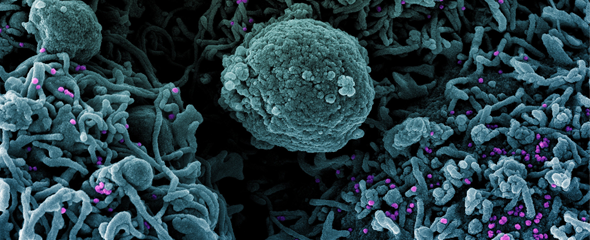SARS-CoV-2 and other viruses whose genetic material consists of ribonucleic acids (RNA) use a propagation trick called programmed ribosomal reading frameshift. In doing so, these viruses prove to be masters of manipulation: they invade host cells and hijack the process the cells use to read the genetic information from a messenger RNA and produce proteins. The viruses alter the strictly maintained reading frame: this allows them to produce their own proteins in order to multiply.
In the search for ways to stop this propagation trick in the SARS-CoV-2 coronavirus, researchers at HIRI have now identified a restriction factor called ZAP. ZAP (Zinc Finger Antiviral Protein) is already known as an immunomodulatory and antiviral protein. "ZAP is a multifunctional molecule in the immune response that can calm an exuberant immune response and shut down viral activity," explains Jun Prof Neva Caliskan, research group leader at HIRI and principal investigator of the study.
Sharp drop in viral load
Until now, it had not been explored whether and how proteins such as ZAP interfere with the ribosomal frameshift of SARS-CoV-2. "The frameshift event has evolved as a hallmark of viral replication. This makes it a very attractive drug target," says Matthias Zimmer, one of the two first authors of the study. "Interestingly, we were able to demonstrate that ZAP binds to the viral RNA that triggers the frameshift," adds the HIRI PhD student from Caliskan's research group “Recoding Mechanisms in Infections”.
"ZAP interferes with the structural folding of coronavirus RNA and disrupts the signal that SARS-CoV-2 sends to induce host cells to produce its replication enzymes," says HIRI PhD student Anuja Kibe, second first author of the study, describing the protein's antiviral effect. And what's more: in collaboration with researchers at the HZI in Braunschweig, which founded the HIRI together with the Julius-Maximilians-Universität Würzburg, the team was able to demonstrate that host cells with elevated levels of ZAP show an approximately 20-fold reduction in the amount of virus they produce. The presence – or absence – of the protein could thus also be an indicator of whether a corona infection takes a mild or severe course.
More research is needed to fully understand the molecular mechanisms behind this. However, the study results are already extremely promising: "Our findings give us hope that ZAP could be used as a template to develop potential new antiviral agents," says Caliskan.
About ZAP in the current study:
Zinc Finger Antiviral Protein (ZAP for short) is a multifunctional immune defence protein that inhibits the replication of certain viruses. It exists in a short (ZAP-S) and a long form (ZAP-L). The effects described in the current studies refer to ZAP-S.
Original publication:
Zimmer M, Kibe A, Rand U, Pekarek L, Ye L, Buck S, Smyth R, Cicin-Sain L, Caliskan N. The short isoform of the host antiviral protein ZAP acts as an inhibitor of SARS-CoV-2 programmed ribosomal frameshifting. Nature Communications, 10.12.2021. DOI: 10.1038/s41467-021-27431-0
The study was supported by funding from the Helmholtz Association, the Lower Saxony Ministry of Science and Culture, and the European Research Council.
